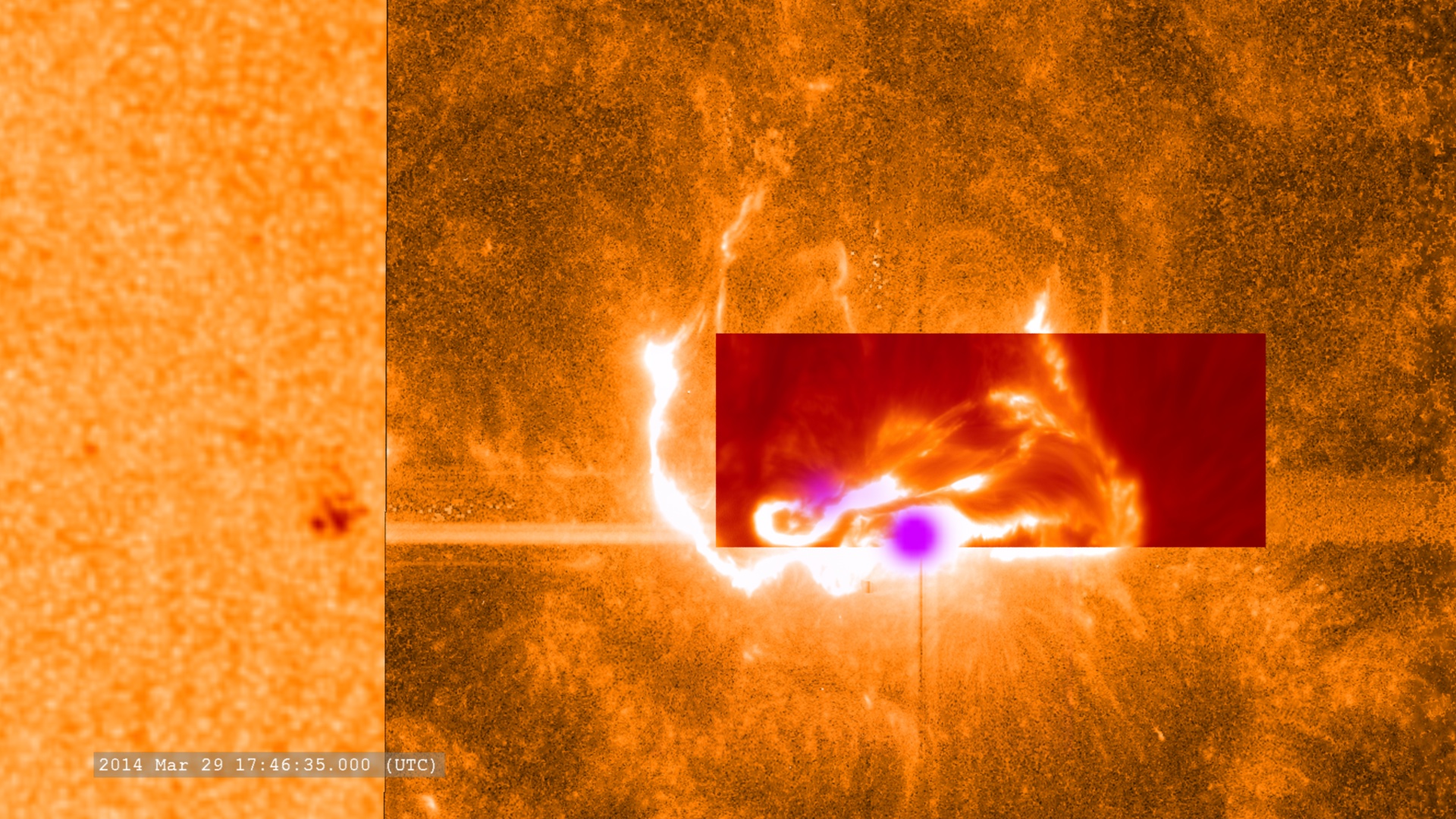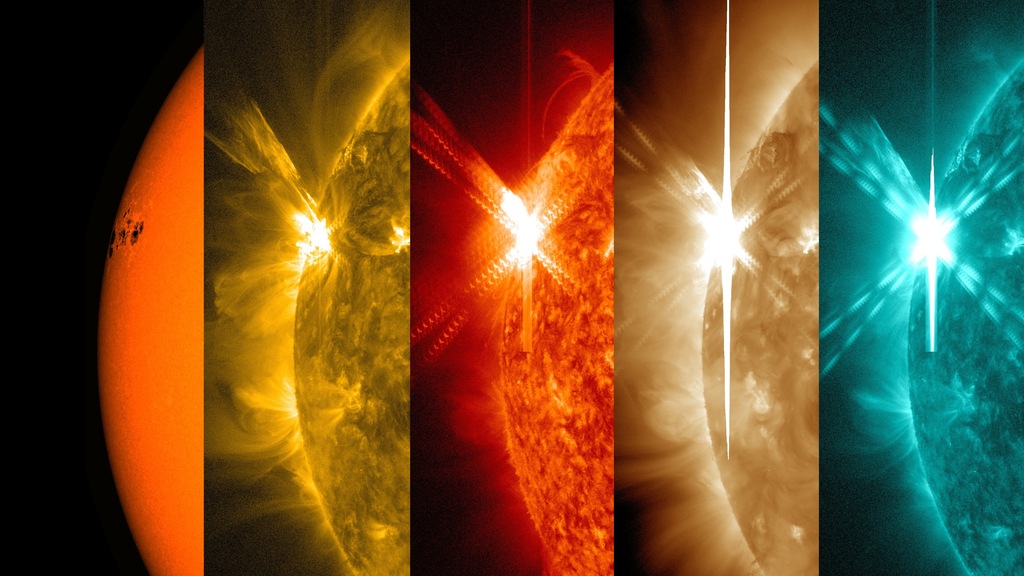ISSI Flare Forecasting International Team
Link to Proposal PDF
Title:
Improving the Reliability of Solar Eruption Predictions to Facilitate the Determination of Targets-of-Opportunity for Instruments With a Limited Field-of-View
Chairs:
Paul Higgins
Manolis K. Georgoulis
Abstract:
A substantial amount of telescope time is wasted on unsuccessful attempts to capture flare observations. Considering the expense of running large ground- and space-based observatories, this lost time can be very costly. We therefore find it timely and paramount to assemble an ISSI Team of international experts with the aim to improve current target-selection methods for the benefit of both flare prediction and instrument planners (e.g., for DKIST, Hinode, IRIS, etc.).
During the proposed ISSI workshop series we will address, and ideally answer, the following science questions:
1. Do flaring sunspot groups emerge as unstable structures, or do they evolve, once emerged, to become unstable?
2. How do sunspot groups build up the energy that is released in eruptions, and what triggers that release?
3. What is the degree of stochasticity in flare occurrence? Can the onset of flares and eruptions, in general, be predicted in a practical manner?
The workshop will comprise two (2) 5-day ISSI meetings spaced roughly a year apart. The first meeting is expected to take place during the autumn of 2014. The first ISSI meeting will address science questions 1 and 2. In doing so, it will consider the physical and observational constraints for observing flares with instruments fearuring partial-disk FOVs such as those of existing and planned observatories. The second ISSI workshop will address science question 3. During the year-long time lapse between it and the first meeting, team members will be primarily developing timeseries of flare-predictive parameters and precursors, as well as of sunspot properties related to flaring.
Expected Outputs:
The intended outputs of the proposed ISSI workshop are:
First ISSI meeting
1. A catalogue of flare-prediction parameters and sunspot-group properties whose timeseries are to be scrutinised for the second meeting;
2. A meeting report, that may evolve into a flare-prediction review paper, summarising the current state of the field- to be the first flare prediction reference for the partial-disk observer.
Second ISSI meeting
1. A document describing the predictive parameters, precursors, and sunspot-group properties, both static (i.e, sunspot classes) and time-dependent (i.e., evolution of total magnetic flux), that are most efficient for the process of selecting ToOs for limited-FOV instruments;
2. The first open and collaborative framework for cross-comparing different flare-forecasting methods that are based on diverse sunspot-group tracking and characterization methods, physical properties, and statistical algorithms;
3. A refereed paper describing the envisioned future trends in solar flare prediction and flare
observations by limited-FOV instruments. In addition, possible collaborative research papers stemming from discussions between Team members.
Meeting 1 - Bern, Switzerland - January 26‐30, 2015
Team
Schedule
Day 1
Day 2
Day 3
Day 4
Day 5
Data Set
Local Information
Contacts
ISSI
Hotel
Restaurants
Meeting 2 - Bern, Switzerland - October 24‐28, 2016
Team Mailing List .txt File
Chair: Paul A. Higgins (TCD / LMSAL / Stanford) (RCAAM of the Academy of Athens)
Co-chair: M. K. Georgoulis (RCAAM of the Academy of Athens)
Young Researcher: Georgios Chintzoglou (George Mason)
Young Researcher: Aoife McCloskey (TCD)
Young Researcher: Yumi Bamba (UoNagoya)
Young Researcher (connecting remotely): Sreejith Padinhatteeri (TCD)
Team Member: Sung-Hong Park (KASI)
Team Member: Katarina Domijan (NUIMaynooth)
Team Member: Lucia Kleint (FWHM)
Team Member: K.D. Leka (NWRA)
Team Member: Monica Bobra (Stanford)
Team Member: Alexandra Trischler (NSO)
Team Member: Ryan Milligan (Goddard/Queen's Belfast)
Team Member: Graham Barnes (NWRA)
Team Member: D. Shaun Bloomfield (TCD)
Team Member: Iain Hannah (UoGlasgow)
Team Member (connecting remotely): Lyndsay Fletcher (UoGlasgow)
External Expert: Neal Hurlburt (LMSAL)
External Expert: Sophie Murray (UK Met Office)
Google Doc with meeting Schedule - You can post comments about it there by doing CTRL-ALT-M.
Google Doc with meeting minutes/notes/action items/discussion
Coffee - 9:00 AM
Agenda begins - 9:30 AM - 5:30 PM
9 am coffee, introductions in the lobby
09:30 Introductory talk about the meeting topics and goals
10:00 Formal introductions/what people are hoping to get out of the meeting
10:30 Lyndsay talk
11:00 coffee break
11:15 Ali talk
12:30 Lunch (followed by coffee)
14:00 Post-lunch discussion
14:30 Ryan talk
15:00 Yumi talk (Hinode Planning)
15:30 coffee break
15:45 Lucia talk
16:35 Iain Talk
17:00 End Day
Evening Dinner (19:00) at Altes Tramdepot (Swiss)
09:00 Coffee
09:30 Review of previous day, overview of the day’s agenda
10:15 Graham Talk
11:05 Coffee
11:15 Yumi Talk (Flare Triggers)
12:20 Lunch followed by coffee
14:00 Georgios Talk
15:00 Coffee
Lucia on molecular lines in Sunspot umbrae spectra
16:00 Sreejith Talk
16:30 Shaun Talk
17:05 Manolis Talk (about FlareCast)
17:30 Review / Discussion / Action Items
17:40 End
Evening Dinner (19:00) at Injera (Ethiopian)
09:00 Coffee
09:30 Review of previous day, overview of the day’s agenda
10:00 Neal Talk
10:20 Shaun to Aoife Intro Talk
10:40 Aoife Talk
11:10 Sophie talk
11:40 Coffee
11:50 KD Talk Skill Score Discussion (Forecasting Validation)
12:30 Lunch followed by coffee
14:00 Katarina Talk
14:30 Sung Hong Talk (A automated system for empirical forecasting of flares)
15:25 Coffee
15:30 Monica Talk
16:20 Graham helioseismology
16:00 Graham/KD All Clear Poster Results
17:10 End
1. Flare Forecasting Review Paper
2. Synoptic Data for Flare Precursors
3. Event Lists
4. Statistical AR Detection Data for Flare Forecasting
5. Detect Sub-region in AR to Point Limited FOV
6. Flare Lists
*Red Denotes currently hosted data
Google Doc Summary of the proposed data set - You can post comments about it there by doing CTRL-ALT-M.
Given the enourmous amount of space needed to host all of the data that we initially proposed (several Tb), we have decided to host the data for just one AR (~100gb): NOAA 10192
To download the data for NOAA 12192, save the TAR files linked on each of the pages below:
*LOS Magnetograms http://jsoc.stanford.edu/SUM61/D643386647/S00000/
*Continuum Images http://jsoc.stanford.edu/SUM0/D643410704/S00000/
*Full Disk Vector Data http://jsoc.stanford.edu/SUM54/D643927153/S00000/
*SHARPs CEA De-Projected Cut-out Vector Data http://jsoc.stanford.edu/SUM33/D643954012/S00000/
This data will only be available until Feb. 1st. Please download it before then, if you plan to analyse it!
If you are intending to analyse the other ARs that we have proposed (we hope that you do!; see below), please contact us ASAP so that we can determine the best way to get you the data.
Complete list of ARs for investigation:
Date range, Cadence
Includes a low-time-resolution overview range, and then a high-time-resolution range for detailed dynamics analysis (changes before/after a flare). The data hosted above only includes the high-time-resolution range.
NOAA 12192
2014/10/17 00:00 --> 2014/10/30 00:00, 3600s
*2014/10/18 00:00 --> 2014/10/27 00:00, 720s
NOAA 11158
2011/02/07 00:00 --> 2011/02/20 00:00, 3600s
2011/02/11 00:00 --> 2011/02/15 00:00, 720s
NOAA 12017
2014/03/20 00:00 --> 2014/04/01 00:00, 3600s
2014/03/24 00:00 --> 2011/04/01 00:00, 720s
NOAA 11967
2014/01/26 00:00 --> 2014/02/10 00:00, 3600s
2014/01/30 00:00 --> 2014/02/06 00:00, 720s
NOAA 12082
2014/06/04 00:00 --> 2014/06/15 00:00, 3600s
2014/06/05 00:00 --> 2014/06/08 00:00, 720s
Series, Segments
Full disk data
*hmi.M_720s, magnetogram
*hmi.Ic_720s, continuum
*hmi.B_720s, inclination, azimuth, disambig, field, conf_disambig
Cut-out data
*hmi.sharp_cea_720s, magnetogram, bitmap, continuum, Br, Bt, Bp
ISSI Local Admin: Maurizio Falanga - +41 (0)31 631 4893
ISSI Travel Admin: Alexandra Lehmann - +41 (0)31 631 4896
The International Space Science Institute is located in the district "Länggasse" very close to Bern main rail station. When standing on the platform, do not walk down into the station itself but rather take the stairway up at the western end of the platform called "Welle". Follow the road walking gradually uphill on Schanzen- and Länggassstrasse. Turn right at Hallerstrasse and find the Institute on the left, street number 6. If you come by public transport "Bern Mobil" you have to take the Bus No. 12 (direction: Länggasse), and get off at the station "Universität".
More Information
Hotel Metropole
Zeughausgasse 26, 3011 Bern, Tel +41 31 311 5021, Fax +41 31 312 1153
Google Map
Walking distance from the main station: 6 minutes
Walking distance from ISSI: ~10 minutes
Note from Alexandra Lehmann:
For your Team Meeting in October a block booking at the hotel Metropole has been made. The Deadline for hotel reservations is on October 6, 2016. Please inform your Team Members to directly send me their arrival and departure dates in Bern until that date. Thank you.
Your Team Members will find the address, telephone number, as well as a city map of Bern showing the location of the hotel, the train station and ISSI on our web site.
At ISSI members will fill in forms for the purpose of per diem reimbursement. Travel costs will not be reimbursed.
ISSI can also provide invitation letters for visa purposes, if needed.
Yelp listings, sorted by ratings
Team Mailing List .txt File
Chair: Manolis K. Georgoulis, RCAAM of the Academy of Athens (replacing Paul A. Higgins)
Co-chair: D. Shaun Bloomfield, University of Northumbria, Newcastle
Young Researcher (connecting remotely): Yumi Bamba (U. Nagoya, Japan)
Young Researcher (connecting remotely): Georgios Chintzoglou (LMSAL, USA)
Young Researcher: Konstantina Loumou (U. Glasgow, UK)
Young Researcher: Aoife McCloskey (TCD, Ireland)
Young Researcher (connecting remotely): Sreejith Padinhatteeri (Manipal U., India)
Team Member: Graham Barnes (NWRA/CoRA, USA)
Team Member: Monica Bobra (Stanford U.)
Team Member (connecting remotely): Katarina Domijan (Maynooth U., Ireland)
Team Member (connecting remotely): Lyndsay Fletcher (U. Glasgow, UK)
Team Member: Iain Hannah (U. Glasgow, UK)
Team Member: Lucia Kleint (FWHM, Switzerland)
Team Member (connecting remotely): K.D. Leka (NWRA/CoRA, USA)
Team Member (connecting remotely): Ryan Milligan (Queen's U. Belfast, UK)
Team Member: Sung-Hong Park (TCD, Ireland)
External Expert: Francesco Berrilli (U. Rome Tor Vergata, Italy)
External Expert: Neal Hurlburt (LMSAL, USA)
External Expert (connecting remotely): Sophie Murray (TCD, Ireland)
Download the Draft Program in PDF
09:30 Welcome and briefing on team objectives
10:00 F Berrilli The calibration pipeline for MOTH II: Magneto-optical filters in two heights in the solar atmosphere
11:00 Coffee break
11:30 L Kleint High-resolution flare observations and their use for prediction
12:30 Lunch
14:00 I Hannah RHESSI flare statistics related to emerging flux
15:00 K Loumou Relationship between the occurrence of flares and the presence of the Hale Sector Boundary
16:00 Coffee break
16:30 Y Bamba (via Skype) Solar flare triggering process based on satellite observations
End of Day
09:30 S Murray (via Skype) Associating CMEs with flares via the HELCATS project and combining results with the FLARECAST property database
10:30 Coffee break
11:00 A McCloskey Flare rates from sunspot groups as per their McIntosh classifications
12:00 Lunch
13:30 K Domijan (via Skype) Flare prediction from SMART features
14:30 S Bloomfield Solar flare rates from combined active region classifications
15:30 Coffee break
16:00 KD Leka (via Skype) U. Hawai`i Halpha Imaging Spectrograph (the "MCCD") and possible role in flare prediction
End of Day
Joint Team Dinner with Team of A. MacKinnon (19:30) at Cha Cha (Thai)
09:30 N Hurlburt Characterization of solar eruptions found with EruptionPatrol / Characterize
09:45 N Hurlburt IRIS / Hinode-SOT flare results
10:30 Coffee break
11:00 G Barnes Practicalities of flare prediction: DAFFS
12:00 Lunch
13:30 M Bobra Recent developments on flare and CME prediction
14:30 S-H Park A statistical study on active region photospheric flows in relation to solar flares
15:30 Coffee break
16:00 G Chintzolglou (via Skype) Evidence for cancellation-driven clustering of flare activity in developing solar active regions
End of Day
Flare Forecasting Team Dinner (19:00) at Kornhauskeller (Swiss)
Dinner team photos (thanks to Neal) Photo 1 Photo 2 Photo 3
09:30 All Discussion on the planned review paper on flare prediction
12:00 Lunch
13:30 S Padinhatteeri (via Skype) Tracking intra-AR magnetic feature movements to identify a potential flaring region
14:30 M Georgoulis Open questions in solar-flare understanding and prediction
15:30 Coffee break
16:00 All General discussion / questions to speakers
End of Day
09:30 All Wrap-up, discussion of the suggested paper plan and final arguments
Noon-ish End of Meeting
Paul A. Higgins - December 17, 2014
Manolis K. Georgoulis - October 2016


